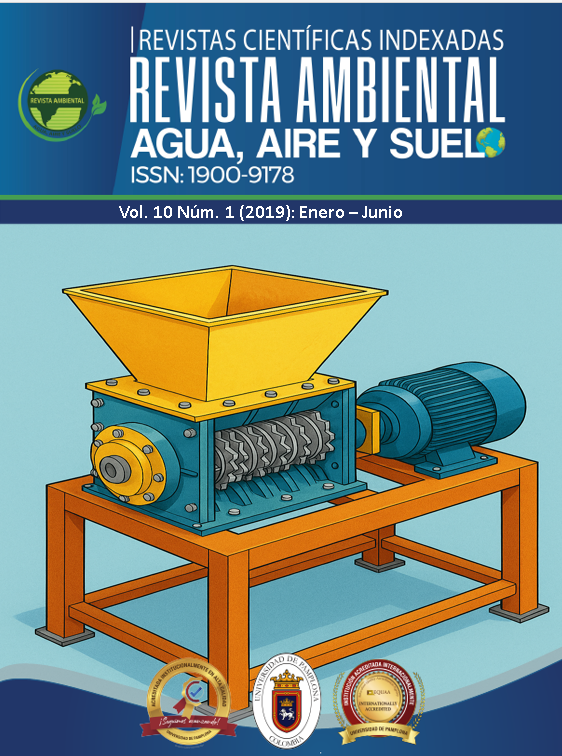Determination of heavy metal concentrations present in PM10 particulate matter in the municipality of San José de Cúcuta, Norte de Santander
DOI:
https://doi.org/10.24054/aaas.v10i1.402Keywords:
Calidad de aire, espectrometría de absorción atómica, fracción respirable y sistemas de información geográficaAbstract
The drastic increase in population and, consequently, in consumerism is a problem with global repercussions. One of these is the decline in air quality, which is affected by anthropogenic activity. Among the main pollutants is PM10 particulate matter, which can contain contaminants such as certain types of hydrocarbons and heavy metals that, depending on their concentration, exposure time, and toxicity, can be deadly or cause significant short- or long-term health problems. It is worth noting that they can affect not only the human body but all living beings in general.
Air quality is monitored in the municipality of Cúcuta in order to track particulate matter (PM10) pollution levels in different areas that may be influenced by sources such as vehicle traffic and industrial processes. The Cúcuta Air Quality Network has three monitoring stations with Hi-Vol equipment for PM10. In this context, the heavy metals present in PM10 particulate matter samples were determined using Atomic Absorption Spectrophotometry in the Control and Quality Laboratory of the University of Pamplona. Traces of Lead, Zinc, Manganese, Copper, and Chromium were identified in the PM10 particulate filters, with copper showing the highest concentrations, and the maximum values being detected at the Panamericana station, unlike the Cinera station, which showed very low concentrations.
Downloads
References
Acevedo, B. J., Bocarejo, S. J., & Velásquez, J. M. (2013). Caracterización de la contaminación atmosférica en Colombia. University College London, Reino Unido; Universidad de los Andes, Colombia.
Arciniegas, A., & Rodríguez, E. (2005). Estudio de la morbilidad en niños menores a cinco años por enfermedad respiratoria aguda y su relación con la concentración de partículas en la localidad de Puente Aranda en Bogotá. Universidad de La Salle, Bogotá, Colombia.
Angulo, W. J., Mendoza, J. A., & Uriel, H. U. (2017). Análisis de la vulnerabilidad por fenómenos de remoción en masa en la cuenca Tanauca: Estudio de caso. Revista Ambiental Agua, Aire y Suelo, 8(2). https://doi.org/10.24054/19009178.v2.n2.2017.3276
ATSDR. (2005). Tox FAQs for heavy metals. Agencia para Sustancias Tóxicas y el Registro de Enfermedades. Recuperado de http://www.atsdr.cdc.gov/tfacts13.html
Brunekreef, B., & Holgate, S. T. (2002). Air pollution and health. The Lancet, 360(9341), 1233–1342.
Camargo, W. C. (2016). Modelación hidrológico-hidráulica de eventos de inundación en el río Bogotá (sector Tocancipá-Chía) usando HEC-RAS. Revista Ambiental Agua, Aire y Suelo, 7(2). https://doi.org/10.24054/19009178.v2.n2.2016.3267
Combariza, B. D. A. (2009). Contaminación por metales pesados en el embalse del Muña y su relación con los niveles en sangre de plomo, mercurio y cadmio y alteración de salud en los habitantes del municipio de Sibaté (Cundinamarca). [Tesis de maestría, Universidad Nacional de Colombia].
Corporación Autónoma Regional de la Frontera Nororiental (CORPONOR). (s.f.). Síntesis ambiental del Norte de Santander. Recuperado de http://www.corponor.gov.co/.
Departamento Administrativo del Medio Ambiente (DAMA). (2003). Resolución 1208 de 2003. Bogotá, Colombia.
Eróstegui, C. R. (2009). Contaminación por metales pesados. Revista Científica Ciencia Médica SCEM, 12(1).
Gao, Y., Nelson, E. D., Field, M. P., Ding, Q., Li, H., Sherrell, R. M., Gigliotti, C. L., Van Ry, D. A., Glenn, T. R., & Eisenreich, S. J. (2002). Characterization of atmospheric trace elements on PM2.5 particulate matter over the New York–New Jersey harbor estuary. Atmospheric Environment, 36, 1077–1086.
Green, J. (2013). La calidad del aire en América Latina: Una visión panorámica. Clean Air Institute. Washington, D.C.
Machado, A., et al. (2008). Contaminación por metales (Pb, Zn, Ni y Cr) en aire, sedimentos viales y suelo en una zona de alto tráfico vehicular. Centro de Investigaciones CEDEGAS, Universidad del Zulia, Venezuela.
Meneses, V. B., Álzate, D., & Mosquera, J. (2016). Sistema de optimización de las técnicas de planificación en agricultura de precisión por medio de drones. Revista Ambiental Agua, Aire y Suelo, 7(2). https://doi.org/10.24054/19009178.v2.n2.2016.3268
Espinel, R. M., Rivera, H. U., & Castellanos, C. (2016). Plan de manejo ambiental para los proyectos de extracción de material de arrastre en las microcuencas quebradas Volcán y Navarro del municipio de Pamplona, Norte de Santander. Revista Ambiental Agua, Aire y Suelo, 7(1). https://doi.org/10.24054/19009178.v1.n1.2016.3282
Gutiérrez, T., Castellanos, C., & Hernández, N. (2016). El ordenamiento territorial frente a las consecuencias de los cambios climáticos. Revista Ambiental Agua, Aire y Suelo, 7(2). https://doi.org/10.24054/19009178.v2.n2.2016.3338
Ivanova, Y., & Sarmiento, A. (2014). Evaluación de la huella hídrica de la ciudad de Bogotá como herramienta de gestión del agua en el territorio urbano. Revista Ambiental Agua, Aire y Suelo, 4(2), 1–5. https://doi.org/10.24054/19009178.v2.n2.2013.427
Downloads
Published
Issue
Section
License
Copyright (c) 2021 REVISTA AMBIENTAL AGUA, AIRE Y SUELO

This work is licensed under a Creative Commons Attribution-NonCommercial 4.0 International License.










